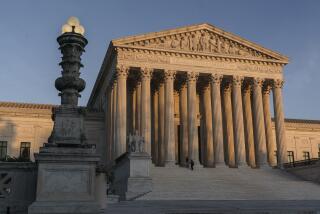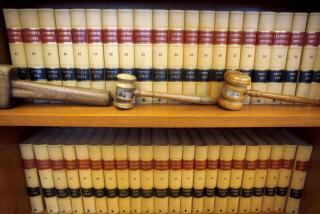ABA’s Judicial-Selection Role in Jeopardy
WASHINGTON — President Bush’s legal advisors are moving to end the American Bar Assn.’s semi-official role in screening potential judges, according to administration officials.
Already, the White House legal team has interviewed more than 50 lawyers for new judgeships, and has done so without consulting the ABA. On Monday, the White House is expected to make official what has become apparent in recent weeks when Bush’s counsel, Alberto R. Gonzales, meets with the ABA’s current president, Martha Barnett of Tallahassee, Fla.
Leaders of the 400,000-member bar association say they have not been told of a pending change.
“I’ve viewed it as a normal meeting for a new administration. It never dawned on me that that’s why they wanted to meet. It should be interesting,” Barnett said. “We’ve been doing this for nearly a half-century,” she added.
White House spokesman Scott McClellan said Saturday, “All I can say is we are moving quickly to fill the [judicial] vacancies.”
But an administration official confirmed that the change in the policy is expected.
Currently, there are 94 vacant seats on the federal bench, which has room for 862 judges. The Bush team has not made any formal nominations of the candidates who have been interviewed.
Although the political battles over these judgeships have escalated in the last 20 years, the importance of the ABA’s role has diminished.
Before 1952, when the lawyers’ group took on the task of evaluating prospective judges, presidents relied almost entirely on the word of U.S. senators. As the result, the bench was staffed with friends and cronies of politicians.
The ABA, in its screening process, stressed professional competence.
Until this year, the bar association has been given advance word on potential judges. Its special team of lawyers would then examine candidates’ experience and legal writings. Judges and lawyers who have worked with the candidates also were asked about their professional reputation. The 15-member committee then rated the prospective nominee as well qualified, qualified or not qualified.
But for several years the ABA has been far from alone in giving advice on judicial candidates. And conservatives have come to view the ABA assessments as biased.
Beginning during the Reagan administration, teams of lawyers at the Justice Department and the White House have pored over the writings and legal opinions of prospective judges.
After a nomination is made, the Senate Judiciary Committee conducts its own thorough evaluation. Outside interest groups, such as the liberal Alliance for Justice and the conservative Judicial Selection Monitoring Project, also closely study nominees and weigh in with their own assessments.
Still, the prospect of the Bush administration ending the ABA’s role in the selection process troubled Nan Aron, executive director of the Alliance for Justice. She said it suggests the White House will put conservative ideology ahead of professionalism in its judicial appointments.
“This looks like a preemptive strike to make sure only ideologically pure candidates are nominated,” she said.
Conservatives, for their part, are still upset over a lukewarm ABA rating given Robert H. Bork when President Reagan nominated him to the Supreme Court. Although the ABA committee gave Bork a “well qualified” rating in 1987, five of the panel’s members dissented. Bork’s nomination went down to defeat in the Senate.
More recently, conservatives have faulted the ABA’s governing board for adopting liberal positions, such as supporting the right to abortion and calling for a moratorium on executions.
More to Read
Get the L.A. Times Politics newsletter
Deeply reported insights into legislation, politics and policy from Sacramento, Washington and beyond. In your inbox three times per week.
You may occasionally receive promotional content from the Los Angeles Times.











